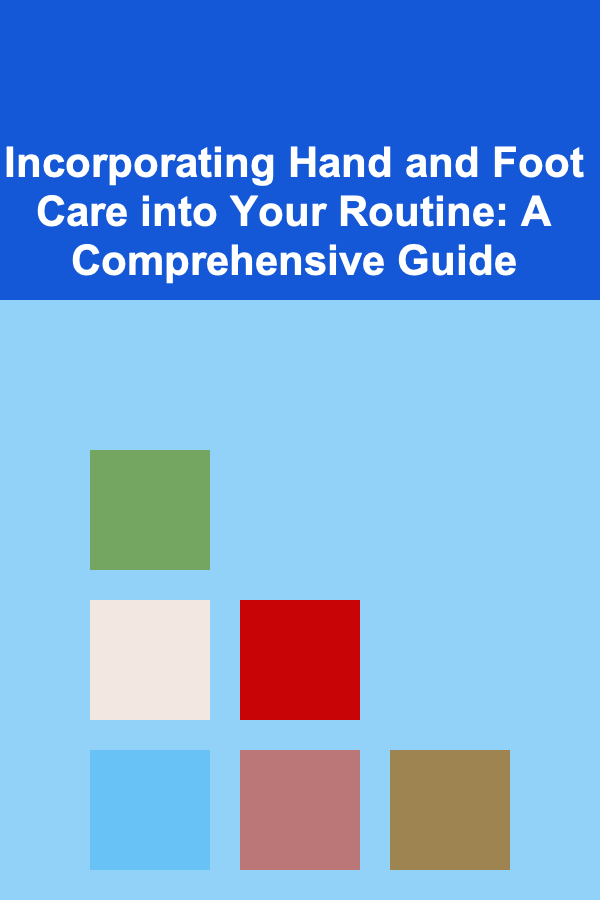
Incorporating Hand and Foot Care into Your Routine: A Comprehensive Guide
ebook include PDF & Audio bundle (Micro Guide)
$12.99$7.99
Limited Time Offer! Order within the next:

Introduction: The Often-Overlooked Essentials
We often dedicate considerable time and resources to skincare for our face and body, meticulously choosing cleansers, serums, and moisturizers. However, our hands and feet, despite being essential tools in our daily lives and bearing the brunt of physical activity, are frequently neglected. This oversight can lead to dryness, cracking, discomfort, and even more serious conditions like infections. Incorporating a consistent hand and foot care routine is not merely a cosmetic consideration; it's a crucial aspect of overall health and well-being. This comprehensive guide will delve into the reasons why hand and foot care is vital, provide practical steps to integrate it into your daily life, and address common concerns and conditions.
Our hands are constantly exposed to environmental stressors, from harsh weather to frequent washing with potentially drying soaps and sanitizers. They are our primary tools for interaction with the world, making them susceptible to cuts, abrasions, and exposure to chemicals. Similarly, our feet endure the daily impact of our weight, the friction of shoes, and exposure to varied surfaces and temperatures. They are often confined in shoes for extended periods, creating a warm, moist environment that can breed bacteria and fungi.
Therefore, a proactive and preventative approach to hand and foot care is essential. This guide aims to provide the knowledge and practical steps necessary to establish a routine that addresses the specific needs of these often-overlooked body parts, promoting comfort, health, and longevity.
Why Prioritize Hand and Foot Care? Beyond Aesthetics
While aesthetically pleasing hands and feet are a welcome benefit, the importance of proper care extends far beyond superficial concerns. Ignoring the needs of these areas can lead to a range of health issues and negatively impact your quality of life.
Health Implications
- Infections: Cracks and cuts in the skin provide entry points for bacteria and fungi, leading to infections like cellulitis (bacterial skin infection), athlete's foot (fungal infection of the foot), and paronychia (infection around the nail).
- Dryness and Cracking: Severe dryness can lead to painful cracks, especially on the heels and fingertips, making everyday activities difficult and potentially increasing the risk of infection.
- Warts: Plantar warts, caused by the human papillomavirus (HPV), are common on the soles of the feet and can be painful and contagious.
- Nail Problems: Ingrown toenails, fungal nail infections (onychomycosis), and brittle nails are common issues that can be prevented or managed with proper care.
- Skin Conditions: Conditions like eczema and psoriasis can manifest on the hands and feet, requiring specific treatment and management to prevent flare-ups.
- Peripheral Neuropathy: Numbness, tingling, or pain in the hands and feet can be a sign of peripheral neuropathy, often associated with diabetes or other underlying medical conditions. Proper foot care is crucial for individuals with neuropathy to prevent complications like foot ulcers.
Impact on Daily Life
Neglecting hand and foot care can significantly impact your ability to perform everyday tasks and enjoy your daily activities. Painful hands and feet can make it difficult to work, exercise, or even walk comfortably. Furthermore, the discomfort and self-consciousness associated with visible skin problems can affect your confidence and social interactions.
Prevention is Key
The good news is that many of these problems can be prevented or managed with a consistent and proactive approach to hand and foot care. By incorporating simple steps into your daily routine, you can maintain the health and comfort of your hands and feet, preventing more serious issues from developing.
Building Your Hand Care Routine: Step-by-Step Guide
A comprehensive hand care routine involves cleansing, moisturizing, exfoliation, and protection from environmental stressors. Here's a step-by-step guide to help you incorporate these elements into your daily life:
1. Gentle Cleansing:
- Choose a Mild Soap: Opt for a soap or hand wash that is free of harsh chemicals and sulfates. Look for products labeled as "gentle," "moisturizing," or "for sensitive skin." Avoid antibacterial soaps for routine hand washing, as they can strip the skin of its natural oils.
- Use Lukewarm Water: Hot water can dry out the skin. Use lukewarm water for washing your hands.
- Wash Thoroughly, But Briefly: While thorough hand washing is essential for hygiene, avoid prolonged washing, as it can irritate the skin. Wash for at least 20 seconds, ensuring you clean between your fingers, under your nails, and the backs of your hands.
- Pat Dry, Don't Rub: After washing, gently pat your hands dry with a soft towel instead of rubbing them vigorously. This minimizes friction and reduces the risk of irritation.
2. Intense Moisturizing:
- Apply Moisturizer After Washing: This is the most crucial step. Apply a generous amount of hand cream or lotion immediately after washing your hands, while the skin is still slightly damp. This helps to lock in moisture.
- Choose the Right Moisturizer: Select a hand cream or lotion that is appropriate for your skin type and needs.
- Dry Skin: Look for thicker creams containing ingredients like shea butter, cocoa butter, glycerin, hyaluronic acid, ceramides, or lanolin.
- Sensitive Skin: Choose fragrance-free and hypoallergenic formulas.
- Eczema or Psoriasis: Consult with a dermatologist for recommendations on specific creams or ointments that are suitable for your condition.
- Reapply Throughout the Day: Moisturize your hands frequently throughout the day, especially after washing, using hand sanitizer, or engaging in activities that can dry out your skin. Keep a tube of hand cream at your desk, in your bag, and by the sink to make it convenient.
- Overnight Treatment: For extra dry hands, apply a thick layer of hand cream or petroleum jelly before bed and wear cotton gloves overnight. This allows the moisturizer to deeply penetrate the skin.
3. Exfoliation:
- Gentle Exfoliation: Exfoliating your hands once or twice a week can help to remove dead skin cells, revealing smoother and brighter skin.
- DIY Scrub: You can easily make a homemade hand scrub using ingredients like sugar, olive oil, and honey. Mix equal parts of sugar and olive oil, add a teaspoon of honey, and gently massage the mixture onto your hands in circular motions for a few minutes. Rinse thoroughly with lukewarm water and apply moisturizer.
- Commercial Scrubs: Alternatively, you can use a commercially available hand scrub. Choose one that contains gentle exfoliating ingredients like sugar, salt, or finely ground seeds.
- Avoid Over-Exfoliation: Avoid over-exfoliating, as this can irritate the skin. Limit exfoliation to once or twice a week and be gentle with the pressure you apply.
4. Sun Protection:
- Apply Sunscreen: Our hands are frequently exposed to the sun, making them susceptible to sun damage. Apply a broad-spectrum sunscreen with an SPF of 30 or higher to your hands whenever you are outdoors, even on cloudy days.
- Reapply Regularly: Reapply sunscreen every two hours, or more frequently if you are washing your hands or sweating.
- Look for Hand Creams with SPF: Some hand creams contain SPF, offering both moisturization and sun protection.
5. Nail Care:
- Keep Nails Trimmed: Trim your nails regularly to prevent them from becoming too long and brittle.
- File in One Direction: File your nails in one direction to prevent splitting and breakage.
- Moisturize Cuticles: Moisturize your cuticles daily with cuticle oil or cream. This helps to keep them healthy and prevent dryness and cracking.
- Avoid Harsh Nail Products: Limit your use of harsh nail polish removers and artificial nails, as they can damage your nails.
6. Protection from the Elements:
- Wear Gloves: Protect your hands from cold weather, harsh chemicals, and abrasive materials by wearing gloves. Wear warm gloves in the winter to prevent dryness and cracking. Wear rubber gloves when washing dishes or cleaning to protect your hands from harsh detergents and chemicals. Wear gardening gloves when gardening to protect your hands from dirt, thorns, and other irritants.
Crafting Your Foot Care Regimen: Prioritizing Comfort and Health
A dedicated foot care routine is essential for maintaining healthy, comfortable feet and preventing a variety of common foot problems. This involves cleansing, moisturizing, exfoliation, and careful attention to nail health.
1. Daily Cleansing and Inspection:
- Wash Feet Daily: Wash your feet daily with soap and lukewarm water. Pay particular attention to cleaning between your toes.
- Thorough Drying: After washing, dry your feet thoroughly, especially between your toes. This area is prone to fungal infections, and moisture can exacerbate the problem. Use a clean towel and pat dry gently.
- Daily Inspection: Inspect your feet daily for any signs of redness, blisters, cuts, sores, or swelling. Early detection of these issues can prevent them from becoming more serious. This is especially important for individuals with diabetes or peripheral neuropathy, who may have reduced sensation in their feet.
2. Regular Moisturizing:
- Apply Moisturizer Daily: Apply a generous amount of foot cream or lotion to your feet daily, especially after bathing.
- Focus on Dry Areas: Pay particular attention to dry areas, such as the heels and soles of your feet.
- Choose the Right Moisturizer: Select a foot cream or lotion that is specifically formulated for feet. These products often contain ingredients like urea or lactic acid, which help to soften and exfoliate dry, calloused skin.
- Urea-Based Creams: Urea is a humectant that draws moisture to the skin and also helps to break down keratin, making it effective for treating thick calluses.
- Lactic Acid Creams: Lactic acid is an alpha-hydroxy acid (AHA) that gently exfoliates the skin, promoting cell turnover and reducing dryness.
- Avoid Moisturizing Between Toes: Avoid applying moisturizer between your toes, as this can create a moist environment that promotes fungal growth.
- Overnight Treatment: For severely dry or cracked heels, apply a thick layer of foot cream or petroleum jelly before bed and wear cotton socks overnight.
3. Exfoliation for Smooth Feet:
- Regular Exfoliation: Exfoliating your feet regularly helps to remove dead skin cells and prevent the buildup of calluses and corns.
- Pumice Stone or Foot File: Use a pumice stone or foot file to gently exfoliate your feet after bathing, when the skin is soft. Avoid being too aggressive, as this can damage the skin.
- Foot Scrubs: You can also use a foot scrub to exfoliate your feet. Look for scrubs that contain ingredients like sugar, salt, or finely ground pumice.
- Chemical Exfoliants: Products containing AHAs or BHAs (beta-hydroxy acids) can also be used to chemically exfoliate the feet. These products can be particularly effective for removing thick calluses.
4. Nail Care: Preventing Problems
- Trim Toenails Straight Across: Trim your toenails straight across to prevent ingrown toenails. Avoid cutting them too short or rounding the edges.
- Use Clean Clippers: Use clean and sharp toenail clippers to prevent the spread of infection.
- File Rough Edges: File any rough edges with a nail file.
- Address Ingrown Toenails: If you develop an ingrown toenail, consult with a podiatrist for proper treatment. Do not attempt to remove the ingrown nail yourself, as this can lead to infection.
- Be Mindful of Nail Polish: While nail polish is generally safe, prolonged use can dry out the nails and make them brittle. Give your nails a break from polish occasionally.
- Watch for Signs of Fungal Infection: Look for signs of fungal nail infection, such as thickening, discoloration, or crumbling of the nails. If you suspect a fungal infection, consult with a doctor or podiatrist for diagnosis and treatment.
5. Shoe Selection and Footwear Hygiene:
- Choose Properly Fitting Shoes: Wear shoes that fit properly and provide adequate support. Avoid shoes that are too tight or too loose, as these can cause blisters, calluses, and other foot problems.
- Alternate Shoes Daily: Alternate between different pairs of shoes daily to allow them to air out and prevent the growth of bacteria and fungi.
- Wear Breathable Socks: Wear breathable socks made of cotton or wool to wick away moisture and keep your feet dry. Change your socks daily, or more frequently if your feet sweat heavily.
- Avoid Sharing Shoes or Socks: Avoid sharing shoes or socks with others to prevent the spread of fungal infections.
- Clean Shoes Regularly: Clean your shoes regularly, especially if they become dirty or wet. Use a disinfectant spray to kill bacteria and fungi.
6. Managing Specific Foot Conditions:
- Athlete's Foot: If you develop athlete's foot, treat it with an over-the-counter antifungal cream or powder. Keep your feet clean and dry, and wear breathable socks and shoes. If the infection does not improve, consult with a doctor.
- Plantar Warts: Plantar warts can be treated with over-the-counter wart removers or by a doctor or podiatrist.
- Calluses and Corns: Calluses and corns can be treated with over-the-counter callus removers or by a podiatrist. Avoid cutting or shaving calluses or corns yourself, as this can lead to infection.
- Bunions and Hammertoes: If you have bunions or hammertoes, wear shoes that are wide enough to accommodate your feet. You may also need to use orthotics or other supportive devices. In severe cases, surgery may be necessary.
7. When to Seek Professional Help:
Consult with a doctor or podiatrist if you experience any of the following:
- Persistent foot pain
- Signs of infection, such as redness, swelling, pus, or fever
- Non-healing sores or ulcers
- Changes in the color or texture of your toenails
- Numbness or tingling in your feet
- Difficulty walking
Addressing Common Hand and Foot Concerns
Despite our best efforts, certain conditions can still arise. Here's how to address some common hand and foot concerns:
Dry, Cracked Hands:
- Intensive Moisturizing: As mentioned, frequent and liberal application of rich hand cream is key. Consider using a heavier ointment or balm at night.
- Humidifier: Use a humidifier, especially in the winter, to add moisture to the air.
- Avoid Irritants: Minimize exposure to harsh chemicals, detergents, and solvents.
- Barrier Creams: Apply a barrier cream before engaging in activities that can dry out your hands.
Dry, Cracked Heels:
- Soaking: Soak your feet in warm water for 10-15 minutes before exfoliating.
- Exfoliation: Use a pumice stone or foot file to gently remove dead skin.
- Moisturizing: Apply a thick foot cream containing urea or lactic acid.
- Occlusive Dressings: Apply petroleum jelly and wear socks overnight to help the moisturizer penetrate deeply.
- Podiatrist Consultation: If cracks are deep and painful, consult a podiatrist for professional treatment.
Calluses and Corns:
- Properly Fitting Shoes: Ensure your shoes fit well and don't create pressure points.
- Pumice Stone: Gently rub calluses and corns with a pumice stone after bathing.
- Salicylic Acid Pads: Use over-the-counter salicylic acid pads to soften and gradually remove calluses and corns. Follow product instructions carefully.
- Podiatrist Consultation: For persistent or painful calluses and corns, see a podiatrist for professional removal and advice on preventing recurrence.
Ingrown Toenails:
- Soaking: Soak your foot in warm water several times a day.
- Lifting the Nail Edge: Gently lift the edge of the ingrown nail with a clean toothpick or cotton swab and insert a small piece of cotton or dental floss underneath. This can help to lift the nail and prevent it from digging into the skin.
- Antibiotic Ointment: Apply antibiotic ointment to prevent infection.
- Podiatrist Consultation: If the ingrown toenail is severely inflamed or infected, consult a podiatrist for professional treatment. They may need to remove part of the nail.
Fungal Infections (Athlete's Foot, Nail Fungus):
- Antifungal Medications: Use over-the-counter antifungal creams, sprays, or powders for athlete's foot. For nail fungus, oral or topical prescription medications may be necessary.
- Hygiene: Keep your feet clean and dry. Wear breathable socks and shoes. Avoid walking barefoot in public places.
- Disinfect Shoes: Disinfect your shoes with an antifungal spray.
- Consult a Doctor: For persistent or severe fungal infections, consult a doctor or podiatrist.
Lifestyle Factors Influencing Hand and Foot Health
While a dedicated routine is important, your overall lifestyle significantly impacts the health of your hands and feet. Consider these factors:
Diet and Hydration:
- Hydration: Drink plenty of water to keep your skin hydrated from the inside out. Dehydration can contribute to dry, cracked skin.
- Nutrients: A balanced diet rich in vitamins and minerals is essential for healthy skin and nails. Focus on foods containing vitamin A, vitamin C, vitamin E, zinc, and omega-3 fatty acids.
Underlying Medical Conditions:
- Diabetes: Individuals with diabetes are at higher risk of foot problems, including nerve damage and poor circulation. Strict blood sugar control and regular foot exams are crucial.
- Peripheral Neuropathy: Nerve damage can lead to numbness and reduced sensation in the hands and feet. Proper foot care is essential to prevent injuries and infections.
- Circulatory Problems: Poor circulation can impair healing and increase the risk of foot ulcers. Consult with a doctor to manage circulatory problems.
- Eczema and Psoriasis: These skin conditions can affect the hands and feet, causing dryness, itching, and inflammation. Consult with a dermatologist for appropriate treatment.
Habits to Avoid:
- Smoking: Smoking impairs circulation, which can negatively impact the health of your hands and feet.
- Harsh Chemicals: Limit your exposure to harsh chemicals, detergents, and solvents. Wear gloves when handling these substances.
- Picking at Skin or Nails: Avoid picking at skin or nails, as this can lead to infection.
- Wearing Tight Shoes: Avoid wearing shoes that are too tight or constricting, as this can cause blisters, calluses, and other foot problems.
Conclusion: A Long-Term Investment in Well-Being
Incorporating hand and foot care into your routine is an investment in your long-term health and well-being. It's not just about aesthetics; it's about preventing infections, managing skin conditions, maintaining comfort, and ensuring you can continue to enjoy your daily activities without pain or discomfort. By following the practical steps outlined in this guide, you can create a personalized routine that addresses your specific needs and promotes healthy, happy hands and feet for years to come.
Remember that consistency is key. Just like any other aspect of self-care, regular attention to your hands and feet will yield the best results. Make it a habit to cleanse, moisturize, and protect these essential body parts, and don't hesitate to seek professional help if you encounter any persistent or concerning issues. Your hands and feet will thank you for it.

How to Choose the Best International Shipping Options Based on Your Target Markets
Read More
How to Incorporate Outdoor Lighting to Enhance Your Garden
Read More
How To Prepare Your Business for Sale
Read More
Mastering Conversion Rate Optimization: A Comprehensive Guide for Performance Marketing Managers
Read More
How to Optimize AR for Outdoor Use
Read More
Identifying and Avoiding CEO Fraud Scams: A Comprehensive Guide
Read MoreOther Products

How to Choose the Best International Shipping Options Based on Your Target Markets
Read More
How to Incorporate Outdoor Lighting to Enhance Your Garden
Read More
How To Prepare Your Business for Sale
Read More
Mastering Conversion Rate Optimization: A Comprehensive Guide for Performance Marketing Managers
Read More
How to Optimize AR for Outdoor Use
Read More